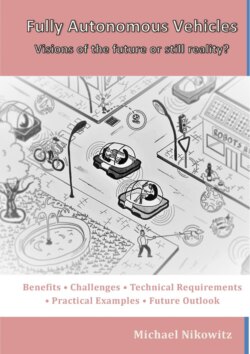Читать книгу Fully Autonomous Vehicles - Michael Nikowitz - Страница 6
На сайте Литреса книга снята с продажи.
1.2 What does a “driverless” vehicle look like?
ОглавлениеThe concept of a driverless vehicle is not totally new.
Even in the year 1957 people thought about what future cars would look like. Fig 1 shows a common portrayal. Here we see a family of four playing a board game while their futuristic electric car drives itself. As this advert from 1957 suggests, the aspiration for self-driving cars is one that has been held for at least half of a century. The text that accompanied the original read: “ELECTRICITY MAY BE THE DRIVER. One day your car may speed along an electric super-highway, its speed and steering automatically controlled by electronic devices embedded in the road. Highways will be made safe by electricity! No traffic jams…no collisions…no driver fatigue.”
Fig 1: Imagination of a self-driving car from 1957 [3]
However, when today people are asked what they imagine driverless vehicles to be like, their responses may differ depending on their generation and their knowledge of current driverless car engineering. The younger and elderly generation imagine “robotic vehicles” when they think about driverless vehicles. As this description consists of the two terms “robotic” and “vehicle”, many adult (and especially elderly) people envision a robot driving a conventional car. An illustration is shown in Fig 2. This figure shows a robot trying to drive a vehicle during the Defense Advanced Research Projects Agency’s (DARPA’s) Robotic Challenge.
This challenge is a competition between teams of robot and software engineers who are trying to develop robots capable of assisting humans in responding to natural and man-made disasters. It was designed to be extremely difficult. Participating teams, representing some of the most advanced robotics research and development organizations in the world, collaborate and innovate on a very short timeline to develop the hardware, software, sensors, and human-machine control interfaces that will enable their robots to complete a series of challenge tasks selected by DARPA for their relevance to disaster response [4].
While the elderly generation imagines a robot (more or less a humanoid one) driving a conventional car, the younger generation thinks about a robot that can transform itself into a conventional car. This conceptualization might be primarily informed by popular movies like “The Transformers”, as it can be seen in Fig 3. At least from today’s point of view, we are far away from such a technology and it might be questionable if we will ever develop such a technology.
Fig 2: What people have in mind when they think about “robotic cars"- a car driven by a robot during the "DARPA"- challenge [5]
Fig 3: A robot that can transform itself into a car [5]
Today’s autonomous cars - or “robotic vehicles”- neither consist of a humanoid robot driving a vehicle, nor a robot transforming itself into a vehicle. Rather, it looks more or less like a conventional vehicle and consists of an array of sensors, actuators, computers, power electronics and communication tools. That’s the reason why the term “robotic vehicle” is not typically applied to contemporary autonomous vehicles. On the one hand it is obvious that these vehicles look and ride like conventional ones, but on the other hand people feel uneasy when they think about robots. Who wants to have a creepy ride?
It’s the same reason why unmanned public transport systems (i.e. subways) are also not called “robotic subways”.
Instead of using the term “robotic”, they are mostly named as "autonomous".
| Autonomous vehicles look like usual vehicles we drive today, taking over from the driver under certain circumstances. Fully autonomous or self-driving vehicles are more advanced. The vehicle will do all the driving, using the same system of sensors, radar and GPS mapping that autonomous vehicles employ. In the context of this book, the term “fully autonomous vehicles” refers to automobiles that are powered by autonomous technologies and are capable of travelling without human control of the vehicle. |
Currently, nearly every car manufacturer is working hard on the development and implementation of such vehicles. At the moment they can be identified by their sensors, which are necessary and mostly placed on the top of the vehicle. But even this recognition feature will disappear within the coming years.
Right now, one of the most popular autonomous vehicles are the driverless cars from Google, which are showed in Fig 4 and Fig 5.
Fig 4: Google's self-driving car (newest generation) [6]
Fig 5: Google's self-driving car (earlier generation) [7]
So, how far away are we today from the visions from the early 1950’s (shown in Fig 1)?
It seems like we are not that far away!
So don’t worry if you see a vehicle coming down the street with nobody sitting inside. It might be a driverless one!
